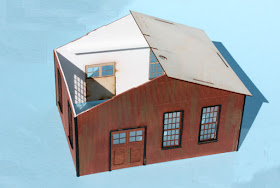I have been putting off building an AL&W Lines kit for a Southern Pacific power house (kit no. SP 21), until I was sure it would fit where I have a kind of blank place on the layout. That space has been occupied for awhile by a cardboard model of a house with a green roof, one that I bought at a swap meet years ago (for more about improvement of this area, see the earlier post: https://modelingthesp.blogspot.com/2020/02/completing-jupiter-pump-compressor.html ). As that post explains, the area is now prepared for a new structure. Here’s a repeat of the original area view.
This AL&W structure kit is for a building roughly 4 by 6 inches in footprint, and of a simple design, though with lots of window and large doors. Below is a photo of a finished kit (built and photographed by Bill Baker), to show what will be completed. It is in the usual SP paint scheme for such structures, of boxcar red walls, black trim, and white window frames and mullions.
The kit has laser-cut styrene walls (Evergreen corrugated) and a variety of peel-and-stick wood detail and trim pieces. I began by choosing the paint scheme for the building (which will not be presented as an SP building), with brown walls and black trim. I chose Tamiya “NATO Brown” (TS-62) for the brown, and used a flat black for all the trim parts.
The recommended first kit assembly step is to assemble the walls to the floor. I chose instead to assemble the walls to each other, using a piece of 1/8-inch square styrene inside each corner. Once the four walls were assembled, I also stiffened the walls with a strip of 1/8 x 1/4-inch styrene above or below the doors and windows. You can see these internal additions below, along with the exterior color.
Next came application of the peel-stick windows and doors, and their frames, and the corner trim. This brings the building sides to a pretty complete look. Note also how different this version of the kit looks, compared to the “official kit photo” above, with its white SP window treatment.
As I mentioned, I chose not to use the floor provided in the kit at this point. I like to leave either the floor area or a separate roof on structures so that if I want to go back and add interior detail or lights, it will be easy to do so.
At this point I added some weathering to the structure, largely a dark gray Pan Pastel vertical streaking in a few areas, and small streaks below the corners of window sills. I went ahead with the kit sequence and added glazing at this point. It is kind of a fussy job to get the clear plastic aligned perfectly with the backs of window assemblies, but if one is off a small amount, decal scissors can be used to remove whatever sticks out. You will not be able to re-insert window assemblies with projecting glazing.
The last step in this first phase is to attach the sub-roof pieces (called “Roof Backing” in the kit). I chose to use canopy glue for this, an excellent adhesive for dissimilar materials (in this case, the styrene walls and plywood sub-roof). I attached each half separately, using small weights to keep them in place.
On the wall segments at left, you can see the “tabs” that fit into slots in the roof pieces (you can click on the image to enlarge it if you wish). Making sure that each of these is engaged in the corresponding slots in the sub-roof ensures that the building will be square.
The concluding steps are to attach the cupola and the outer roof surfaces. I will return to this project in a future post.
Tony Thompson





No comments:
Post a Comment